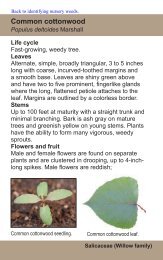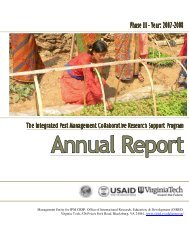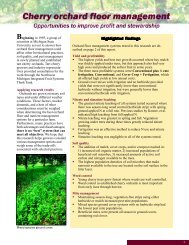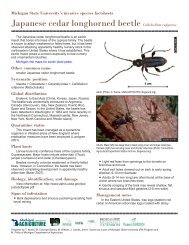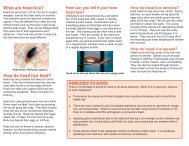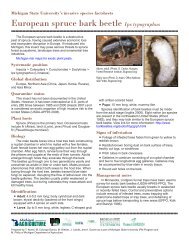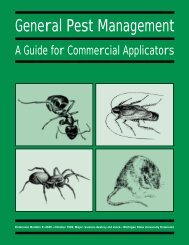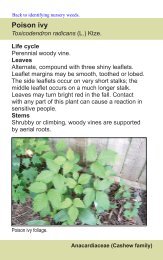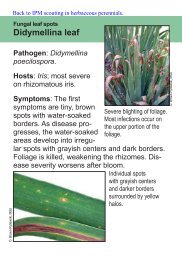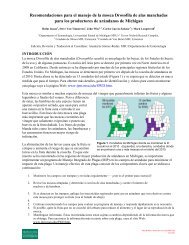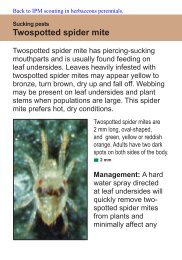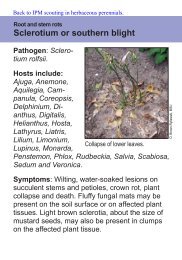Whole Manual - Michigan State University: Integrated Pest ...
Whole Manual - Michigan State University: Integrated Pest ...
Whole Manual - Michigan State University: Integrated Pest ...
Create successful ePaper yourself
Turn your PDF publications into a flip-book with our unique Google optimized e-Paper software.
DAMPING OFF<br />
Pathogen type: fungus (Pythium spp., Phytophthora spp.)<br />
Disease symptoms: Damping off is a seedling disease<br />
that may be caused by several fungi, most commonly<br />
Pythium. Symptoms of damping off include wilting,<br />
browning and death. Seedlings are attacked at the<br />
ground level and develop water-soaked, discolored<br />
stems. Infected plants topple over and seldom recover.<br />
Yield loss due to Pythium damping off can be as severe as<br />
100 percent.<br />
Environmental conditions favoring disease: Infection<br />
rates can be high, particularly during periods of cool, wet<br />
weather. The fungus enters plant cells and consumes all<br />
cellular material, killing the cells and the plant. If the<br />
infection occurs in a mature plant, the host may be able to<br />
resist fungal growth but may exhibit stunting and a yield<br />
reduction.<br />
Control strategies:<br />
■ Control soil moisture. Do not overwater seedlings<br />
(although this is not always in your control). Good<br />
drainage is important in limiting disease development.<br />
Compost and other soil amendments may help<br />
to improve drainage and air circulation and thereby<br />
decrease disease occurrence.<br />
■ Plant at times conducive to rapid plant growth to minimize<br />
the opportunity for infection.<br />
■ Crop rotation helps to decrease the incidence of<br />
damping off.<br />
■ Chemical controls are sometimes recommended for<br />
difficult cases, but they may not be cost effective.<br />
DISEASES OF CELERY<br />
ASTER YELLOWS<br />
Aster yellows also infects celery. Please refer to the<br />
carrot disease section for information on aster yellows.<br />
SEPTORIA LEAF BLIGHT (Late Blight)<br />
Late blight in celery causes leaf spots that contain small,<br />
spore-filled black bodies.<br />
Pathogen type: fungus (Septoria apiicola)<br />
Disease symptoms: Somewhat circular spots on leaves<br />
and petioles can cause defoliation in severe cases. Lesions<br />
are tan to gray and contain small, black bodies resembling<br />
small grains of pepper to the unaided eye. These are<br />
actually black, flask-shaped structures that are embedded<br />
in diseased leaf tissue and contain the spores that spread<br />
the disease. Over time, leaf spots merge and kill the leaf.<br />
Environmental conditions favoring disease: When the<br />
spore-filled structures become wet from rainfall or dew<br />
on leaves, spores are forcibly pushed onto the leaf surface.<br />
They are then spread by spattering raindrops or by<br />
clinging to machinery or skin or clothing of workers<br />
passing through the field. Spores within water droplets<br />
can be spread by strong winds during thunderstorms. It<br />
takes 12 days under normal conditions for symptoms to<br />
appear after an infection has occurred.<br />
Control strategies:<br />
■ Plant disease-free seed and transplants.<br />
■ Plow under infected celery after harvest.<br />
■ Practice crop rotation with at least one year out of celery.<br />
■ Limit movement of machinery and workers in fields<br />
to reduce the spread of the disease.<br />
BACTERIAL LEAF BLIGHT<br />
Pathogen type: bacterium (Pseudomonas apii)<br />
Disease symptoms: Irregular, circular, rusty-red spots up<br />
to five millimeters (0.20 inch) in diameter appear on the<br />
leaves.<br />
Environmental conditions favoring disease: Disease<br />
development is favored by warm, moist conditions. The<br />
bacteria require ten hours of continuous leaf wetness and<br />
moderate temperatures to infect foliage. Bacterial leaf<br />
blight is a seedborne bacterium that spreads rapidly in a<br />
greenhouse because of the dense plant canopy and high<br />
humidity. In the field, bacterial spread is enhanced by<br />
overhead irrigation. The bacteria overwinter in undecomposed<br />
celery residue.<br />
Control strategies:<br />
■ Hot water seed treatment will reduce seedborne<br />
inoculum but may also reduce seed germination.<br />
■ To minimize disease development and spread in<br />
greenhouses, space plants to allow adequate air<br />
movement, water early enough in the day to allow<br />
foliage to dry by evening, and utilize heating and<br />
venting to maintain the relative humidity below 85<br />
percent.<br />
■ Do not plant diseased transplants.<br />
■ Avoid overhead irrigation to minimize the spread of<br />
the disease.<br />
■ Copper-based fungicides applied on a regular basis<br />
can limit disease spread.<br />
Vegetable Crop <strong>Pest</strong> Management 63<br />
Chapter 7



